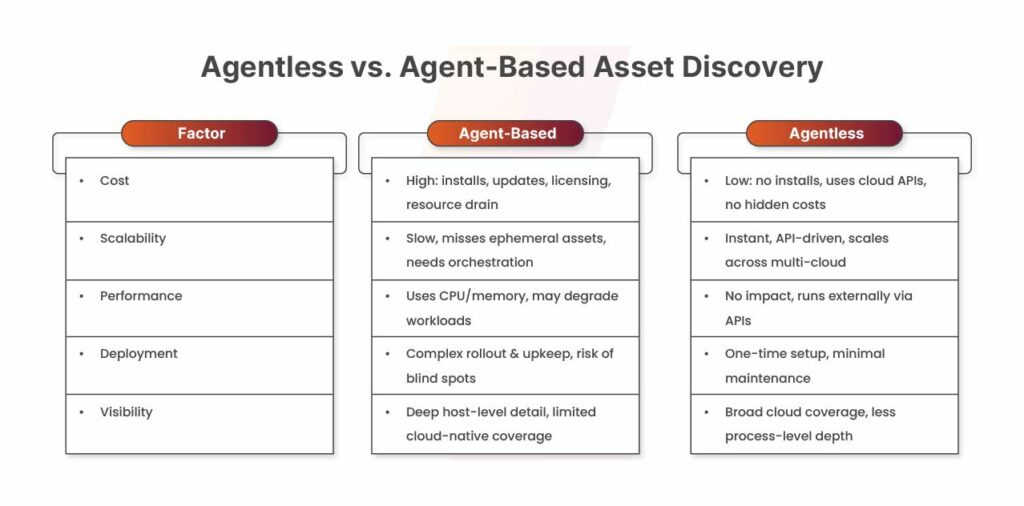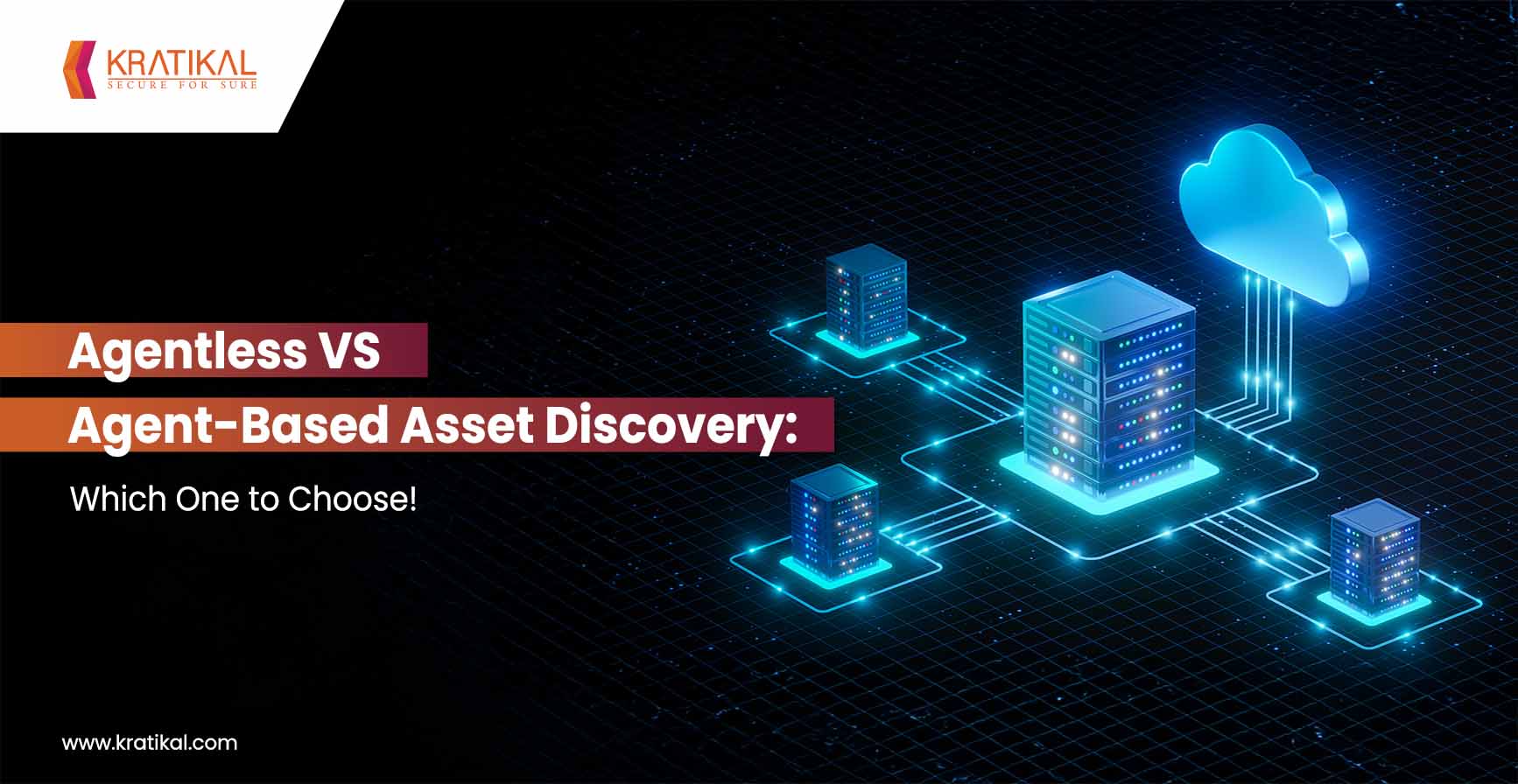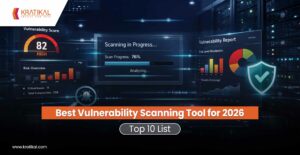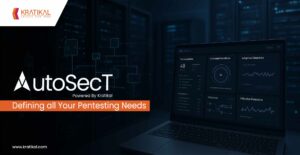When you’re running on public cloud services like AWS, Azure, or Google Cloud, keeping track of what you actually have out there is easier said than done. The cloud is constantly moving, virtual machines pop up, containers spin down, databases expand, storage buckets appear and disappear. Miss one, and you risk compliance issues or even a security blind spot. That’s why cloud security teams need a clear way to discover and inventory every resource in real time. Today, there are two main ways to do it: agent-based and agentless asset discovery. But which one should you choose? Let’s find out!
Table of Contents
- 0.1 Understanding Asset Discovery Approaches
- 0.2 Agentless vs. Agent-Based Asset Discovery – Cost and Operational Overhead
- 0.3 Agentless vs. Agent-Based Asset Discovery – Scalability in Dynamic Cloud Environments
- 0.4 Agentless vs. Agent-Based Asset Discovery – Performance Impact on Workloads
- 0.5 Agentless vs. Agent-Based Asset Discovery – Deployment Complexity and Maintenance
- 0.6 Agentless vs. Agent-Based Asset Discovery – Visibility and Depth of Information
- 1 Book Your Free Cybersecurity Consultation Today!
- 2 Get in!
Understanding Asset Discovery Approaches
Asset Discovery is the process of identifying and cataloging all computing assets and services in an environment. In cloud contexts, this means continuously tracking resources across accounts and regions to know “what’s out there” at any given time. There are two ways to gather this information:
Agent-Based Asset Discovery
This approach installs lightweight agents on each VM, server, or endpoint to collect detailed system data, OS configuration, installed software, running processes, and even memory usage. It offers deep, real-time visibility but requires managing agents on every asset, a method common in older on-prem and cloud tools.
Agentless Asset Discovery
Here, no software is installed on assets. Instead, tools use cloud provider APIs or network protocols to enumerate resources and gather metadata. For example, APIs from AWS, Azure, or GCP can reveal instances, databases, and serverless functions. Some solutions even scan VM snapshots externally for richer insights. The key advantage: it’s external, non-invasive, and easier to scale.

Agentless vs. Agent-Based Asset Discovery – Cost and Operational Overhead
When comparing costs, it’s important to consider both direct costs and operational overhead:
Agent-Based Cost Factors
Scaling agents across hundreds or thousands of assets is resource-heavy. Each agent needs installation, updates, and monitoring, consuming staff time and sometimes causing downtime. Agents also eat into CPU and memory, adding hidden compute costs, and may carry per-host licensing fees. Together, this makes agent-based discovery costly to run and scale.
Agentless Cost Factors
Agentless methods avoid per-host installs, running instead as centralized or cloud-native services. This reduces administrative effort and leverages built-in tools like AWS Config for cost efficiency. With no performance drag on individual assets and no licensing per node, agentless approaches generally cut both operational complexity and total ownership costs.
Agentless vs. Agent-Based Asset Discovery – Scalability in Dynamic Cloud Environments
Modern cloud environments are highly dynamic; servers can be created or terminated on demand, auto-scaling groups expand or contract resources automatically, and containerized or serverless workloads may live only for minutes. Scalability is thus a crucial factor:
Agent-Based Scalability Challenges
In dynamic clouds, every new VM or container needs an agent deployed, usually through scripts or pre-baked images. But with short-lived or ephemeral workloads, agents may never install in time, leaving blind spots. Constant orchestration is required to keep pace, and in fast-scaling environments, this lag often results in missed assets and higher overhead. responsive to rapid scaling and prone to missed assets when workloads churn quickly.
Agentless Scalability Advantages
Agentless discovery scales naturally with cloud elasticity. By connecting directly to cloud APIs, it can detect new resources instantly without waiting for software installs. A one-time API integration provides ongoing visibility across accounts and providers, covering even short-lived workloads. In multi-cloud setups, agentless tools consolidate inventory from AWS, Azure, and GCP, delivering broad, rapid scalability with minimal overhead.
Agentless vs. Agent-Based Asset Discovery – Performance Impact on Workloads
The act of discovering assets should not unduly burden the systems being discovered. Here, the difference is stark:
Agent-Based Performance Impact
Agents consume CPU, memory, and I/O on every host they monitor. While small individually, the impact adds up at scale or during deep scans, competing with business applications for resources. In cloud environments, this overhead not only risks performance degradation but also inflates compute costs. Poorly coded or stuck agents can even crash workloads, making them risky in resource-sensitive setups.
Agentless Performance Impact
Agentless discovery operates externally, pulling data via APIs or remote queries without touching the workload itself. Since it interacts with the cloud control plane rather than the instance, there’s virtually no impact on system performance. This makes agentless scanning ideal for continuous or on-demand visibility, ensuring coverage without slowing down applications or adding hidden costs.
Agentless vs. Agent-Based Asset Discovery – Deployment Complexity and Maintenance
Setting up and maintaining an asset discovery solution can range from trivial to highly complex, depending on the approach:
Agent-Based Deployment
Rolling out agents across all assets is complex and labor-intensive. Teams must integrate deployment into VM images or automation pipelines and continuously update and manage each agent. Any missed installation leaves blind spots, while outdated or misconfigured agents create risks. With every host generating logs and events, troubleshooting and maintaining consistency quickly becomes a heavy operational burden.
Agentless Deployment
Agentless discovery is much simpler. A one-time setup, like creating a read-only IAM role in AWS or an app registration in Azure, enables instant visibility without installing anything on hosts. With no per-node software to update, ongoing maintenance is minimal, reducing both complexity and attack surface. This streamlined model lets teams focus on analyzing assets rather than managing agents.
Agentless vs. Agent-Based Asset Discovery – Visibility and Depth of Information
A core purpose of asset discovery is to provide visibility into the environment. The breadth and depth of that visibility can differ by approach:
Agent-Based Visibility
Running directly on the host, agents deliver deep insights, configurations, software inventory, processes, open connections, even kernel versions or package vulnerabilities. This makes them powerful for detailed host-level visibility. But coverage depends on consistent deployment: if an asset lacks an agent, it’s invisible. In fast-moving cloud environments, maintaining 100% coverage is difficult, and agents often miss cloud-native services entirely.
Agentless Visibility
Agentless tools prioritize breadth. By querying cloud provider APIs, they quickly enumerate all assets across accounts, VMs, databases, containers, serverless functions, and more. This ensures no resource is overlooked, including ephemeral workloads where agents can’t be deployed. While agentless may lack the same process-level depth as agents, the trade-off is broad, near-instant visibility across the entire cloud estate, a major advantage for inventory and security coverage.
Book Your Free Cybersecurity Consultation Today!
Why AutoSecT Agentless Asset Discovery Fits Cloud Environments?
Cloud environments, by design, are elastic and ever-changing. Agentless asset discovery through AutoSecT is particularly well-suited to this paradigm for several reasons:
Speed and Agility
Get instant visibility with no rollout delays. Perfect for audits, incident response, or fast-changing CI/CD pipelines where resources appear and vanish quickly.
Reduced Operational Overhead
No agents to install or maintain. Smaller teams save time and cost, focusing on analyzing data instead of troubleshooting tooling.
Scalability and Elasticity
One central setup scales seamlessly across accounts, regions, and even multi-cloud (AWS, Azure, GCP). No need to manage separate deployments.
Compatibility with Cloud-Native Services
Goes beyond VMs; discovers databases, serverless, containers, and managed services where agents can’t run, aligning with CSPM best practices.
Improved Security Posture
Fewer moving parts mean fewer attack surfaces. Continuous, agentless visibility ensures no asset slips through the cracks, reducing blind spots and risks.
Get in!
Join our weekly newsletter and stay updated
In today’s elastic and fast-moving cloud environments, blind spots are security risks waiting to happen. While agent-based discovery offers deep host-level detail, it struggles with scalability, performance impact, and deployment complexity. Agentless discovery, on the other hand, provides instant, broad visibility across multi-cloud estates with minimal overhead, making it the smarter choice for modern cloud security and compliance. The bottom line: in dynamic clouds, breadth beats depth, and agentless is the way forward.
FAQs
- What is the difference between agentless and agent-based asset discovery?
Agent-based discovery installs software on each asset to collect deep system details, while agentless discovery uses cloud APIs to scan and inventory resources without installing anything.
- Why is agentless asset discovery better for cloud environments?
Agentless discovery scales instantly across accounts and regions, detects short-lived resources, and covers cloud-native services, all without performance overhead or complex deployments.
- How does AutoSecT improve agentless asset discovery?
AutoSecT takes agentless discovery further by delivering real-time visibility across multi-cloud environments (AWS, Azure, GCP) without adding performance overhead. It detects even short-lived resources, discovers cloud-native services where agents can’t run, and reduces operational complexity, helping teams stay audit-ready and secure with minimal effort.








Leave a comment
Your email address will not be published. Required fields are marked *